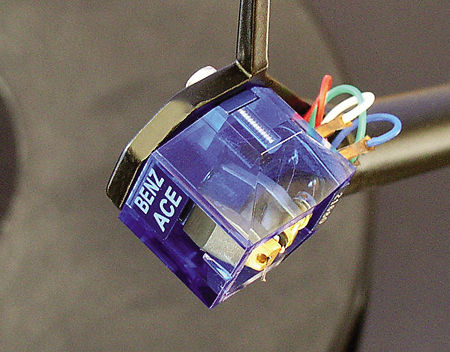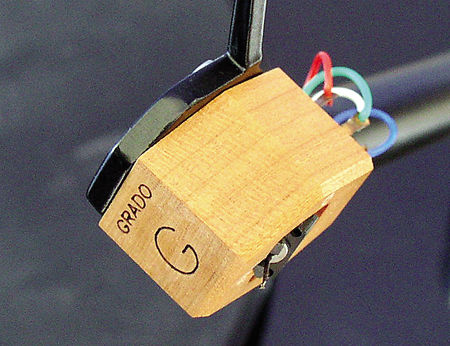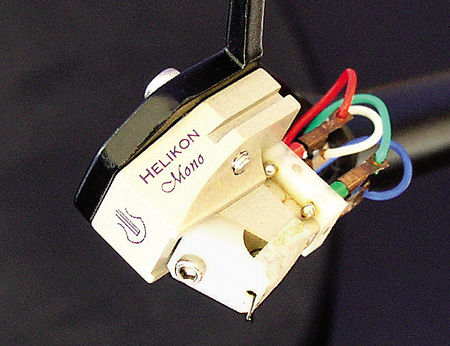| Columns Retired Columns & Blogs |
Listening #30 Page 2
That technique will also lessen the severity of tics and pops on mono records, because it increases the amplitude of the music signal relative to, and separate from, the noise. Also, keep in mind that, on a mono LP, dirt and damage exist as vertical groove "modulations" (of the unintentional sort): They're the only things, apart from warps, that will move the stylus and generator up and down. In a two-channel groove, the only other time you see a purely vertical modulation is with left- and right-channel signals that are equal in frequency and amplitude but out of phase with each other. Therefore, if you play a mono disc with a stereo cartridge whose output has been "rechanneled" per Steve Hoffman's suggestion, any damage or dirt that is purely vertical in its physical structure will cancel out when the two channels are blended together.
Footnote 4: Lyra Helikon Mono. US distributor: Immedia, 1101 Eighth Street, Suite 210, Berkeley, CA 94710. Tel: (510) 559-2050. Fax: (510) 559-1855. Web: www.immediasound.com.
But remember, this only works with mono records. If you don't have a dedicated mono turntable, you'll have to plug in and unplug your new adapter thingie every time you switch formats. And if you do have a dedicated mono turntable . . . well, why the heck can't you just buy a mono cartridge, too?
Lyra Helikon Mono cartridge
The Lyra Helikon Mono (footnote 4) remains the most mono cartridge I've used: It appears similar to its stereo stablemates, yet the Helikon Mono's generator is a unique design, with two separate coils, wound on the two sides of a rectangular former that's oriented parallel to the record's surface. So although the generator is physically free to move however it pleases, it's electrically insensitive to vertical modulations of any sort. (Lyra could have gotten away with a single continuous coil, of course, but they used two coils and two electrically separate pairs of output pins as a guard against ground-loop hum in a stereo system; in a true mono system, the Helikon Mono owner can use either pair of pins.)
The Helikon Mono also has a stylus tip that's wider than Lyra's usual, and which the designer says is more appropriate to a mono microgroove: 3 by 70µm instead of 3 by 30µm. I can't say what that does or doesn't account for in real performance terms without comparing it to a Helikon Mono with a regular-size tip (something I assume Lyra's designers have already done), but it appears to do no harm. In my experience, no one makes a phono cartridge that shrugs off vinyl noise better than a Lyra, and the Mono carries on that tradition—which is no mean feat when you consider the advanced age and horrid condition of some of my monos.
For that reason, and for its consistently colorful, dramatic, and involving performance, the Lyra Helikon Mono is one of my most cherished audio toys. But at a US price of $2195, reasonable though that may be in terms of the cost of making the thing, it's beyond the reach of most people. Luckily, a few more affordable alternatives have appeared since the Helikon's release, and I recently spent some quality time with two of them: the high-output version of the Benz ACE Mono (footnote 5) ($550) and the Grado Reference Sonata Mono ($500) (footnote 6).
Benz ACE Mono
As with Benz's other high-output ACE models, the Mono has a blue acrylic housing, and uses a solid boron cantilever with a line-contact stylus measuring 6 by 40µm. The ACE Mono's compliance is medium to medium-high, and a highish load impedance is recommended. The suggested tracking force is 2gm, and the cartridge body is just tall enough that users of Rega tonearms will need to use a single 2mm spacer.

The Benz appears to be a stereo cartridge that's been optimized for mono rather than a mono design from the ground up—but even so, someone's done a nice job of optimizing. The cruciform coil former, usually oriented to the surface of the record like a letter X, is rotated 45º in the ACE Mono, so the coils respond only to horizontal movement. Also, the two pairs of coils are electrically connected at the output pins, hot to hot and ground to ground.
I used the cartridge-alignment tone (300Hz, L–R, +6dB) on Hi-Fi News & Record Review's Test Record (HFN 001) to see how well the Benz would reject vertical modulations. I was impressed: The ACE Mono was every bit as quiet as the Helikon Mono, with only a trace of the 300Hz tone breaking through. Not bad!
More important, the ACE Mono sounded fine on real records. It needed some running-in, before which the Benz sounded a little tizzy. But as the days wore on it matured into a tight, neutral-sounding pickup with an especially good sense of scale on big music and an unusually (for an affordable high-output cartridge) smooth and nongrainy top end. The ACE Mono was rhythmically fine on upbeat music, with no sense of lagging at all, and while it was never as noiseless as the Helikon Mono—a difference that may in fact be down to the different styli—it was nonetheless excellent. The Benz sailed through my noisy Dinu Lipatti discs, and while it didn't completely silence the scratches on a rough copy of Sviatoslav Richter's Recital (Deutsche Grammophon LPM 18849), it did better in that regard than any stereo cartridges I've tried.
One other "test" deserves mention. Listening to Serge Koussevitzky's 1944 recording of Tchaikovsky's Symphony 5 (RCA LM-2901) with the Benz ACE Mono was a musical revelation. The sound of the double basses in the Andante cantabile was surprisingly forceful and textured, and although the recording is obviously compressed, the ACE Mono gave a good account of how Koussevitsky interpreted (and sometimes exaggerated) the music's dynamic markings. This record isn't an example of what I'd call great mono—but it is great music, and the Benz got to the bottom of it.
Grado Labs Reference Sonata Mono cartridge
The Reference Sonata Mono from Grado Labs is a very different thing. It isn't a moving-coil or a moving-magnet cartridge, but rather a moving-iron design in which the inner end of the cantilever is capped with a tiny iron nub, the movement of which induces a current in a series of adjacent magnet-and-coil assemblies.

The Reference Sonata Mono is an unambiguously high-compliance cartridge with a "doped" cantilever made from five telescoping segments of aluminum, fitted with an elliptical stylus of undisclosed size. Interestingly, the Grado seems to have the same stylus-tip-to-mounting-hole distance as the Benz: Their screws wound up in virtually the same spots in the Rega's headshell. It's also close to the same height, so, once again, a 2mm Rega spacer brought the tonearm to the right height and the cantilever to the right angle. I tracked the Grado at 1.6gm but eased back on the antiskating: Too much was (audibly) too much.
As with most of the other wood-bodied cartridges from Grado Labs, the inside of the Reference Sonata Mono is "potted," with three different damping compounds; because of that, and because its stylus assembly isn't user-removable, I couldn't poke around to see what makes it work. But company president John Grado told me that the coils and magnets of their mono cartridges are physically reconfigured so that horizontal movement is favored over vertical, electrically speaking. The above-mentioned HFN/RR test track bore that out—although the Grado's vertical-modulation output was very slightly louder than that of the Lyra and Benz cartridges.
Still, the Grado did an excellent job of overlooking physical groove damage and baked-on dirt: Despite its apparently lower rejection of vertical modulation, it was no noisier than the Benz—although that may also have been due to the Grado's somewhat softer, warmer presentation. My only disappointment was that it didn't track loud singing voices and loud piano chords quite as cleanly as did the Benz and Lyra.
The Reference Sonata Mono was a wonderfully human-sounding cartridge, at times breathtakingly so. When I used it to play a mono reissue of Bob Dylan's The Times They Are A-Changin' (Columbia/Sundazed LP 5108), I was impressed by the sense of touch it brought to the guitar playing, and the way it made the differences clear when Dylan sang with more head tone than chest tone. Equally impressive was the Grado's spatial performance (I hesitate to come right out and say imaging): Here, finally, was "hear-around mono." The voice sounded whole, and the guitar sounded physically separate from it.
The Grado also did a fine job of playing more complex LPs, such as Classic Records' mono reissue of Roy Orbison's In Dreams (Monument MLP 8003). It captured all the lovely details in the arrangement without making them small or mechanical, and the electric bass, though sounding just a bit softer than it should have, was still pacey and tuneful, not to mention downright pretty. And if you still don't think mono can be spatially impressive, you should hear how the Grado handled the layering in "Shadaroba": Despite not being strung out between the speakers, all the instruments were distinct from one another, with even some suggestion of relative scale. Very darn nice, and a lot more than I ever thought $500 would buy.
Yet more mono cartridges
There's even more: Lyra has introduced two new cartridges to straddle the Helikon: the Dorian Mono ($749) and the Titan Mono ($5500). Sakura Systems, the US distributor of Miyabi cartridges and 47 Laboratory electronics, now imports a Miyabi Mono ($2500). I haven't heard it, but if it's in the same league as the magnificent Miyabi 47 ($3995), then it's worth checking out. At the other end of the spectrum, Ortofon still produces their moving-magnet OM D25M mono cartridge, which retails for only $60 in the US. I tried one recently, and while it doesn't compete with the new mono cartridges from Grado, Benz, and Lyra—and I suppose it's unreasonable to expect a $60 cartridge to sound like a mono version of the same company's fine Jubilee or Kontrapunkt models—the spherical-tipped Ortofon may at least be what you need to get a dedicated mono deck up and running.

Do it while you're young: Almost all of the classical LPs I see at thrift stores these days, and a large portion of the pop albums, are in mono. There's no telling how long it will be before they, like most of the decent stereo discs, get snapped up, too. And remember: The list of recording artists who never recorded in stereo includes Bix Beiderbecke, King Oliver, Johnny Dodds, Django Reinhardt, Charlie Patton, Bascom Lunsford, Uncle Dave Macon, Wilhelm Furtwngler, Arturo Toscanini, Ignaz Paderewski, Rosa Ponselle, Robert Johnson, Willem Mengelberg, and Gid Tanner and his Skillet Lickers. Ignore them at your peril!
Footnote 4: Lyra Helikon Mono. US distributor: Immedia, 1101 Eighth Street, Suite 210, Berkeley, CA 94710. Tel: (510) 559-2050. Fax: (510) 559-1855. Web: www.immediasound.com.
Footnote 5: Benz can actually supply any of their cartridges in a mono version. Benz ACE Mono. US distributor: Musical Surroundings, 5662 Shattuck Avenue, Oakland, CA 94609. Tel: (510) 547-5006. Fax: (510) 547-5009. Web: www.musicalsurroundings.com.
Footnote 6: Grado Reference Sonata Mono. Manufacturer: 4614 Seventh Avenue, Brooklyn, NY 11220. Tel: (718) 435-5430. Web: www.gradolabs.com.
- Log in or register to post comments




































